
Hey! How are you doing, people? Long time no see.
This time I bring you a different kind of Korean series compared to the others I reviewed so far. As for the genre, the series I'm talking about today differs a little from the last reviews I've done – it's a mix between psychological horror and fantasy, with tons of action and, certainly, tons of gore scenes, sensitives topics which may cause triggers and... swearing. Yes, it may sound strange but the latter isn't something common to see in Korean productions, since TV censorship there is restricted regarding some certain things. However, as it's a Netflix original production, this drama differs from the "traditional" ones not just in terms of censorship, but also regarding its structure as a whole – it was divided into 3 confirmed seasons so far, the first one having just 10 episodes. Second and third seasons are yet to be released.
Based on the 2017 famous homonymous webtoon, "Sweet Home" (in hangul: 스위트홈) is set in a post-apocalyptic scenario, where a group of people is forced to fight a mysterious epidemic in order to stay alive. Its title is purposely ironic – obviously, there's nothing sweet in this drama, given the brief above and the pictures. Instead, it contradicts directly the sequence of tragedies and disasters that occur through the story.
¡Oye! ¿Cómo están, gente? Cuánto tiempo.
Esta vez les traigo un tipo diferente de serie coreana en comparación con las otras que revisé hasta ahora. En cuanto al género, la serie de que hablo hoy difiere un poco de las últimas reseñas que he hecho – es una mezcla entre terror psicológico y fantasía, con mucha acción y, ciertamente, muchas escenas gore, temas sensibles que puede causar gatillos y... palabrotas. Sí, puede sonar extraño, pero esto último no es algo común de ver en las producciones coreanas, ya que la censura televisiva de allá es restringida con respecto a algunas cosas. Sin embargo, como es una producción original de Netflix, este drama difiere de los "tradicionales" no solo en términos de censura, sino también en cuanto a su estructura en general – fue dividido en 3 temporadas confirmadas hasta el momento, la primera con solo 10 episodios. La segunda y tercera temporada aún no se han estrenado.
Basado en el famoso webtoon homónimo de 2017, "Sweet Home" (en hangul: 스위트홈) es ambientado en un escenario postapocalíptico, donde un grupo de personas se ven obligadas a luchar contra una misteriosa epidemia para mantenerse vivos. Su título es intencionadamente irónico – obviamente, no hay nada dulce en este drama, dado el resumen anterior y las imágenes. En cambio, este contradice directamente la secuencia de tragedias y desastres que ocurren a lo largo de la historia.
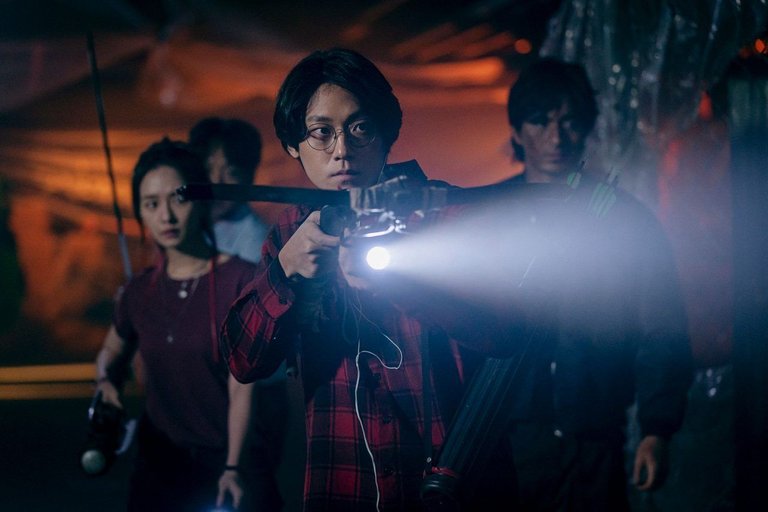
Synopsis
Cha Hyun-su (Song Kang) is an introvert and reclusive boy with suicidal tendencies, whose depressed behavior, caused by severe bullying he suffered at school, was only made worse after the tragic accident that took the lives of his whole family. Alone, he moves to an old and damaged complex of apartments called "Green Home" – there, he only plans to survive until his suicide day comes – after all, there was nothing else left that could hold him to life.
Before he could put his plan into action, he witnesses weird things happening outside his room – suddenly, his neighbors start turning into frightening monster-like creatures and start killing each other. Even terrified to the bone, he goes out to get some help from possible survivors and ends up meeting Yoon Ji-su (Park Gyu-young), a bass player who lives upstairs and Jung Jae-heon (Kim Nam-hee), a very religious teacher who has impressive sword skills. Together, they go find a safe place to stay.
Meanwhile on the ground floor, all the ways out of the building had been locked up. Lee Eun-hyeok (Lee Do-hyun), Seo Yi-kyung (Lee Si-young) and a group of residents were trying to open the main gate, clueless about the situation outside, until the moment a monster broke into the building and killed a resident, causing a mass hysteria among them. It was only a matter of time before they found out what was going on – outside the building, the chaos had already set in and the Green Home residents find themselves surrounded on all sides by all kinds of monsters. Isolated, the group of complete strangers to each other are forced to live together and rely on one another in order to survive.
Cha Hyun-su (Song Kang) es un chico introvertido y recluido con tendencias suicidas, cuyo comportamiento depresivo, causado por el bullying severo que sufrió en la escuela, solo se agravó después del trágico accidente que acabó con la vida de toda su familia. Solo, se muda a un viejo y dañado complejo de apartamentos llamado "Green Home" – allí, solo planea supervivir hasta que llegue el día de su suicidio – a fin de cuentas, no quedaba nada más que pudiera mantenerlo con vida.
Antes de que pudiera poner su plan en acción, él presencia cosas extrañas sucediendo fuera de su habitación – de repente, sus vecinos comienzan a convertirse en criaturas aterradoras como monstruos y comienzan a matarse entre sí. Aún aterrorizado hasta los huesos, sale a buscar ayuda de posibles supervivientes y acaba conociendo a Yoon Ji-su (Park Gyu-young), una bajista que vive al piso de arriba y Jung Jae-heon (Kim Nam-hee), un maestro muy religioso que tiene impresionantes habilidades con la espada. Juntos, buscan un lugar seguro para quedarse.
Mientras tanto, en el primer piso, todas las salidas del edificio habían sido cerradas. Lee Eun-hyeok (Lee Do-hyun), Seo Yi-kyung (Lee Si-young) y un grupo de residentes intentaban abrir la puerta principal, sin tener idea de la situación exterior, hasta el momento en que un monstruo irrumpió en el edificio y mató a un residente, provocando una histeria colectiva entre ellos. Era solo cuestión de tiempo antes de que descubrieran lo que estaba pasando – fuera del edificio, el caos ya se había desatado y los residentes de Green Home se encuentran rodeados por todos lados por todo tipo de monstruos. Aislados, el grupo de completos extraños entre sí se ven obligados a vivir juntos y depender unos de otros para supervivir.
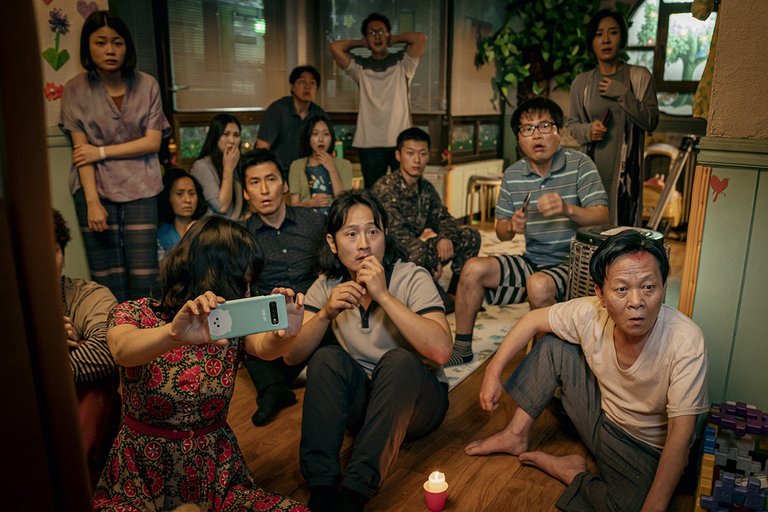
The survivors of the ground floor
Fight for survival
Even before Hyun-su knew what was going on outside his room, there were some moments when he faces some dilemmas regarding the life and death dichotomy that he'd been dealing with for a while. Before joining the other survivors, he even considered moving up his suicide plan, after all, why would he have to continue living – and hence suffering – even in a chaotic world like that?
However, it was just a matter of time before he was pushed to make the final decision. An unexpected incident put Hyun-su's courage and, especially, his empathy to the test, making him resignify the concepts of life and death within the new reality. At the last moment, he chose to live and fight not only for his survival, but also for those around him – but he wasn't expecting that his decision of living would put the lives of those he wanted to save in danger. That's when he discovers he's infected.
Antes de que Hyun-su supiera lo que estaba pasando fuera de su habitación, hubo algunos momentos en los que se enfrenta a algunos dilemas relacionados a la dicotomía vida y muerte con la que ha estado lidiando durante un tiempo. Antes de unirse a los otros supervivientes, hasta consideró adelantar su plan de suicidio, a fin de cuentas, ¿por qué tendría que seguir viviendo – y por lo tanto sufriendo – incluso en un mundo caótico como aquel?
Sin embargo, fue solo cuestión de tiempo antes de que fuera presionado a tomar la decisión final. Un incidente inesperado puso a prueba el coraje de Hyun-su y, especialmente, su empatía, haciéndole resignificar los conceptos de vida y muerte dentro de la nueva realidad. En el último momento, él eligió vivir y luchar no solo por su supervivencia, sino también por los que lo rodeaban – pero no esperaba que su decisión de vivir pondría en peligro la vida de aquellos a los que quería salvar. Ahí es cuando descubre que está infectado.
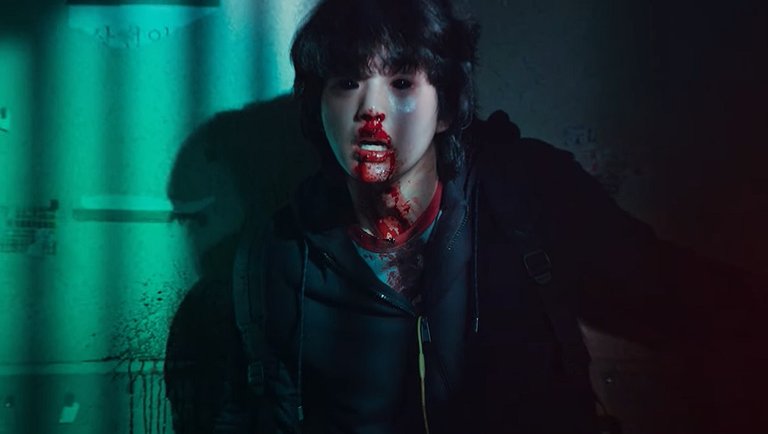
Hyun-su in the middle of the process of monstrification
Monstrification
The series introduces us, right at the beginning, to the process of monstrification up close as well as explains a little bit what is behind it. One of the reasons that sets Sweet Home apart from other zombie/monster/apocalyptic productions is that it doesn't use the famous cliché of the "mutant virus turns people into creatures" that we repeatedly see in most productions of the genre – and the icing on the cake lies in here. Instead, monstrification is a process that begins in the human mind, coming from the inside out until it takes the whole body.
Before becoming a monster, the person shows some specific symptoms, like heavy nosebleeds and hallucinations. One of the first characters to show symptoms is Hyun-su. While he was hallucinating, the drama shows several flashbacks of his past, which will let the viewers know more about his background, as well as the reasons why he was "infected" – after all, it isn't a contagious infection, but a psychological process that can affect anyone who surrenders to oneself's monster side and falls into its mindtraps while hallucinating. Though Hyun-su chose to live, his monster version were always teasing his rational, human side to give up on fighting and just succumb to his inner desires. That being said, desire is the key to monstrification.
La serie nos presenta, desde el principio, al proceso de monstrificación de cerca y explica un poco lo que hay detrás de él. Una de las razones que distingue a Sweet Home de otras producciones de zombis/monstruos/apocalípticas es que esa no utiliza el famoso cliché del "virus mutante que convierte a las personas en criaturas" que vemos repetidamente en la mayoría de las producciones del género – y la cereza del pastel se encuentra aquí. En cambio, la monstrificación es un proceso que comienza en la mente humana, viniendo de adentro hacia afuera hasta que abarca todo el cuerpo.
Antes de convertirse en monstruo, la persona muestra algunos síntomas específicos, como fuertes hemorragias nasales y alucinaciones. Uno de los primeros personajes en mostrar síntomas es Hyun-su. Mientras alucinaba, el drama muestra varios flashbacks de su pasado, que permitirán a los espectadores saber más sobre su pasado, así como las razones por las que estaba "infectado" – a fin de cuentas, no es una infección contagiosa, sino un proceso psicológico que puede afectar a cualquiera que se rinda al lado monstruoso de sí mismo y caiga en sus trampas mentales mientras alucina. Aunque Hyun-su eligió vivir, su versión monstruo siempre estaba provocando su lado racional y humano para que dejara de luchar y simplemente sucumbiera a sus deseos internos. Dicho esto, el deseo es la clave para la monstrificación.
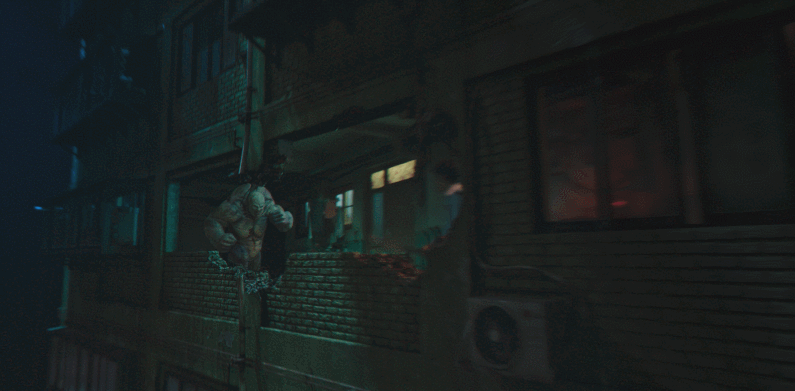
Another iconic character: the protein monster
Golden hour
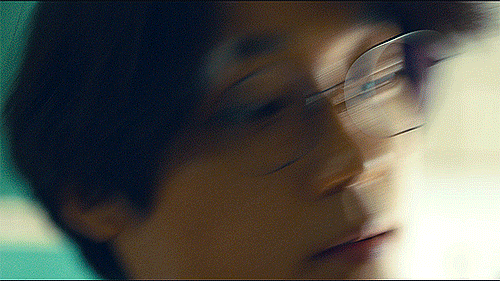 Despite making some questionable decisions, Eun-hyeok tried his best to guarantee the group's safety
Despite making some questionable decisions, Eun-hyeok tried his best to guarantee the group's safety
During an official government broadcast on TV, the survivors could learn more not just about what was known over the monstrification epidemic so far, but also how to efficiently kill the monsters before they could fully transform and therefore achieve the ability to regenerate themselves. This period of vulnerability is referred in the drama as the golden hour – that's when the infected ones are showing symptoms and transitioning between monster and human. However, if someone could somehow resist the transformation by controlling their desires, after about 15 days, their body would stabilize and the symptoms would cease – that's what happens to Hyun-su.
Due to this, Lee Eun-hyeok, the group leader, decided to take advantage of Hyun-su's regenerative condition for the group's sake, making him run errands and do the dangerous work outside the safe zone in exchange for living with them. Not all the survivors were in line with his decision, though. It's fact that Hyun-su represented a huge risk to the group's safety given his condition, but, was it right to kill him while he was still human? How did Hyun-su feel when he knew that some survivors wanted to kick him out, even after helping them?
Durante una transmisión oficial del gobierno en la televisión, los supervivientes pudieron aprender más no solo sobre lo que se sabía sobre la epidemia de monstrificación hasta el momento, sino también sobre cómo matar a los monstruos de manera eficiente antes de que pudieran transformarse por completo y, por lo tanto, alcanzar la capacidad de regenerarse. Este periodo de vulnerabilidad es referido en el drama como la golden hour – es cuando los infectados muestran síntomas y hacen la transición entre monstruo y humano. Sin embargo, si alguien pudiera resistir de algún modo a la transformación controlando sus deseos, después de unos 15 días, su cuerpo se estabilizaría y los síntomas cesarían – eso es lo que le sucede a Hyun-su.
Debido a esto, Lee Eun-hyeok, el líder del grupo, decidió aprovecharse de la condición regenerativa de Hyun-su por el bien del grupo, haciéndole hacer mandados y trabajos peligrosos fuera de la zona segura a cambio de vivir con ellos. Sin embargo, ni todos los supervivientes estaban de acuerdo con su decisión. Es hecho que Hyun-su representaba un gran riesgo para la seguridad del grupo dada su condición, pero ¿era correcto matarlo mientras aún era humano? ¿Cómo se sintió Hyun-su cuando supo que algunos supervivientes querían echarlo, incluso después de ayudarlos?

Symbolisms
One of the most interesting aspects of Sweet Home's story arc are indeed the psychological dramas that surround – and connect with – the main conflict. Although the monster trope is definitely the eye-catcher and main appeal in general, the drama has obviously much more to offer than blood spilling and grotesque, cartoonish CGI monsters fighting each other. Instead, the monsters are used metaphorically to portray the characters' inner conflicts, so, in fact, the series' real focus is how they would deal with their desires, as an attempt to overcome monstrification. Going a bit more deeper, these conflicts are not just personal or specific issues, but they are related to humanity's as a whole – the best and, especially, the worst of human nature.
In short, monsters are nothing but the materialization of each person's darkest side – it just depended on each one's desires so this inner monster would manifest itself – or not – and, depending on the kind of desire, it was possible to one also become a harmless monster, like Im Myung-sook, the stroller woman – who deserved more focus in general, just like in the webtoon. These allegories make the viewers think about the role reversal between monsters and humans – after all, who are the true monsters? Those who are unconsciously violent and destructive or those who have the free will to choose violence and hate?
Uno de los aspectos más interesantes del arco narrativo de Sweet Home son, ciertamente, los dramas psicológicos que rodean – y conectan con – el conflicto principal. Aunque el tropo de los monstruos es definitivamente el centro de atención y el principal atractivo en general, Sweet Home tiene mucho más que ofrecer que derramamiento de sangre y monstruos grotescos y caricaturescos de CGI luchando entre sí. En cambio, los monstruos son usados metafóricamente para retratar los conflictos internos de los personajes, así que, de hecho, el real enfoque de la serie es cómo ellos lidiarían con sus deseos, como un intento de superar la monstrificación. Profundizando un poco más, estos conflictos no son solo cuestiones personales o específicas, sino que están relacionados con la humanidad como un todo – lo mejor y, especialmente, lo peor de la naturaleza humana.
En resumen, los monstruos son nada más que la materialización del lado más oscuro de cada persona – solo dependía de los deseos de cada uno para que este monstruo interior se manifestase – o no – y, dependiendo del tipo de deseo, también era posible convertirse en un monstruo inofensivo, como Im Myung-sook, la del cochecito de bebé – que merecía más atención en general, tal como en el webtoon. Estas alegorías hacen que los espectadores piensen en el cambio de papeles entre monstruos y humanos – a fin de cuentas, ¿quiénes son los verdaderos monstruos? ¿Los que son inconscientemente violentos y destructivos o los que tienen el libre albedrío para elegir la violencia y el odio?
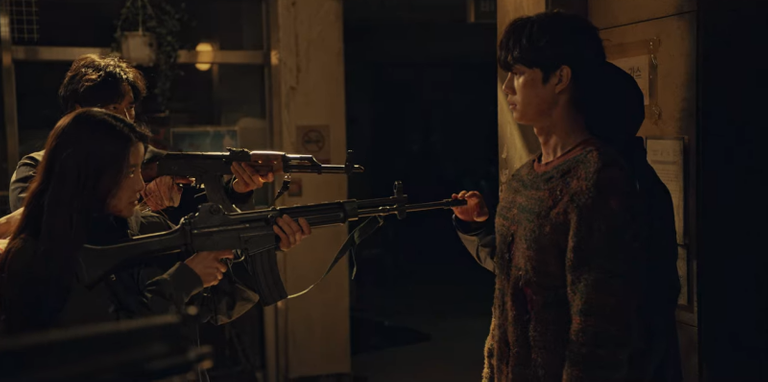
"There are monster that don't hurt people, but... Is there anyone who doesn't hurt monsters?"
Humanity?
When the survivors found out that anyone who couldn't control their desires were bound to transform at any time, a wave of panic and despair spread among them. It's fact that humans tend to react instinctively faced with dangerous situations – at that point, everyone was a potential menace – so a second wave of hatred towards the unknown was caused as a result of fear – however, these negative feelings were nothing but triggers to their inner monsters. Of course, not all of them reacted negatively, though – like Ji-su or Park Yu-ri (Go Yoon-jung) who chose to save Hyun-su and Sang-wook, respectively, even though the two girls weren't sure if they were still human or not.
These multiple sides of the human nature are depicted by the use of a bunch of stock characters, which are generic and high relatable types, but there are also more dynamic ones which had significative changes in their arc through the episodes. An example of "positive" change is Lee Eun-yu (Go Min-si), the bratty and rebel Eun-hyeok's younger sister who showed her soft-hearted side through the story course, in contrast to Yi-kyung, the brave, helpful and once altruist firefighter who had a "negative" change after being pushed against the wall by the military for knowing too much – although Yi-kyung character wasn't originally in the webtoon, her presence, as well as of those linked to her became crucial to the modified plot, besides her contribution to lots of cool action scenes. Speaking of which, there weren't that many major changes in the Netflix adaptation until episode 3 or 4 – that's when Yi-kyung story arc was deepening and therefore split up from the webtoon's plot.
Cuando los supervivientes descubrieron que cualquiera que no pudiese controlar sus deseos estaba destinado a transformarse en cualquier momento, una ola de pánico y desesperación se propagó entre ellos. Es un hecho que los humanos tienden a reaccionar instintivamente ante situaciones peligrosas – en aquel momento, todos eran una amenaza potencial – así que una segunda ola de odio hacia lo desconocido fue provocada como resultado del miedo – sin embargo, estos sentimientos negativos no eran más que desencadenantes de sus monstruos internos. Por supuesto, ni todos reaccionaron negativamente – como Ji-su o Park Yu-ri (Go Yoon-jung) que eligieron salvar a Hyun-su y Sang-wook, respectivamente, aunque las dos chicas no estaban seguras si ellos seguían siendo humanos o no.
Estos múltiples lados de la naturaleza humana son representados por el uso de un puñado de personajes tipo, que son tipos genéricos y altamente identificables, pero también hay otros más dinámicos que tuvieron cambios significativos en su arco a lo largo de los episodios. Un ejemplo de cambio "positivo" es Lee Eun-yu (Go Min-si), la malcriada y rebelde hermana menor de Eun-hyeok, que mostró su lado bondadoso a lo largo del curso de la historia, en contraste con Yi-kyung, la valiente, servicial y antes altruista bombera que tuvo un cambio "negativo" después de ser empujada contra la pared por los militares por saber demasiado – aunque la personaje de Yi-kyung no estaba originalmente en el webtoon, su presencia, así como la de aquellos vinculados a ella, se volvió crucial para la trama modificada, además de su contribución a muchas escenas de acción geniales. Hablando de eso, no hubo tantos cambios importantes en la adaptación de Netflix hasta el episodio 3 o 4 – fue entonces cuando el arco de la historia de Yi-kyung se profundizó y, por lo tanto, se separó de la trama del webtoon.
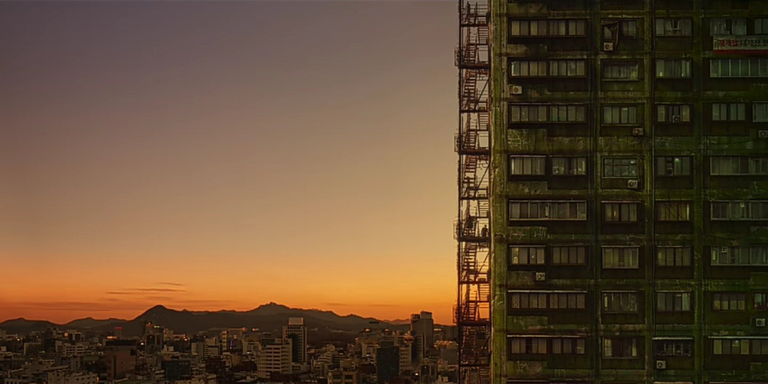
The closed and restricted setting instigates the viewer to know what is happening outside
Hostility
It wasn't just human desires that were represented by the idea of monstrification, nor just the different nuances of human nature. The way Hyun-su's depression is portrayed is neither romanticized nor banalized – the viewer get to see, even briefly, the motivations and triggers which led him down the path of self-harm and suicide attempts, also how he managed to control his inner monster – a metaphor of him not simply overcoming depression, but coexisting with it. The series shows a realistic point of view about such a common yet taboo mental disorder like depression and, especially, demystify the thought that every depressed person can be cured, or, in the worst case, that suicide is the only option left. The fact that he continued helping those who harassed and outcasted him, even getting seriously injured as a result, was an example that the depression was still there, in form of self-harm, but still he chose kindness over hate – one of the reasons he turned into a "special" monstrified-human.
Besides Hyun-su, there's another character who was outcasted as much as he was, for the worst reasons. Pyeon Sang-wook (Lee Jin-wook), the mysterious gangster whose true personality has nothing to do with his looks and pose, is by far one of my favorite characters, his story arc is one of the most interesting in my opinion. Unlike Hyun-su, Sang-wook wasn't going through monstrification so the hostility towards him was purely prejudice, especially after the group saw him taking the law into his own hands – but once we got to know his noble reasons as well as his painful past, there's no way not to sympathize – and perhaps empathize – with him.
No eran solo los deseos humanos que estaban representados por la idea de monstrificación, ni solo los diferentes matices de la naturaleza humana. La forma en que la depresión de Hyun-su es retratada no es idealizada ni banalizada – el espectador puede ver, aunque sea brevemente, las motivaciones y los desencadenantes que lo llevaron por el camino de autolesión e intentos de suicidio, también cómo logró controlar su monstruo interior – una metáfora de él no simplemente superando la depresión, sino coexistiendo con ella. La serie muestra un punto de vista realista sobre un trastorno mental tan común pero tabú como la depresión y, sobre todo, desmitifica la idea de que toda persona deprimida puede curarse o, en el peor de los casos, que el suicidio es la única opción que queda. El hecho de que siguiera ayudando a aquellos que lo hostigaban y desechaban, incluso quedando gravemente herido como resultado, fue un ejemplo de que la depresión todavía estaba allí, en forma de autolesión, pero aun así eligió la bondad sobre el odio – una de las razones por las que se convirtió en un humano-monstrificado "especial".
Además de Hyun-su, hay otro personaje que fue desechado tanto como él, por las peores razones. Pyeon Sang-wook (Lee Jin-wook), el misterioso gángster cuya verdadera personalidad no tiene nada que ver con su apariencia y pose, es de lejos uno de mis personajes favoritos, su arco narrativo es uno de los más interesantes en mi opinión. A diferencia de Hyun-su, Sang-wook no estaba pasando por la monstrificación, así que la hostilidad hacia él era puramente prejuiciosa, especialmente después de que el grupo lo vio haciendo justicia por mano propia – pero una vez que conocemos sus nobles razones así como su doloroso pasado, no hay cómo no simpatizar – y quizás empatizar – con él.
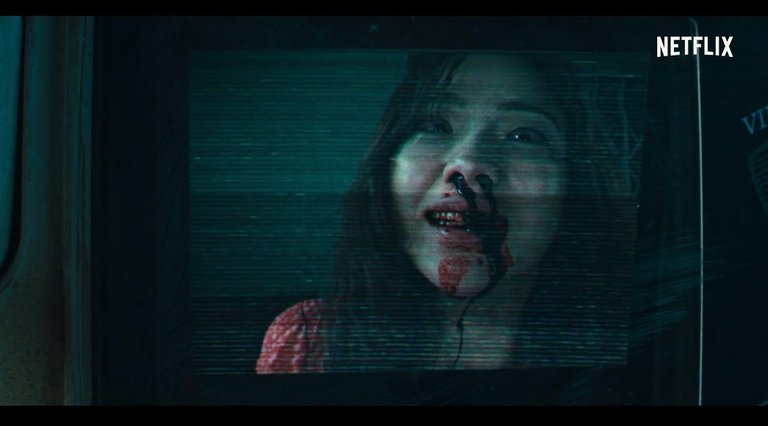
The "hungry neighbor" scene is just unforgettable
Final thoughts
After watching the series, the plot delighted me so much that I couldn't help but read the webtoon to find out how it was going to end – however, Sweet Home's last episode has almost nothing to do with the original plot, mostly due to the addition of Yi-kyung story arc. That doesn't necessarily mean the story was ruined, though – actually, I'm pretty curious to know how some new elements will fit in that apocalyptic universe. Moreover, the final cliffhanger is awesome, it leads the viewer to a new mystery to be explored in the next seasons, as well as a new reality to the survivors left – by the way, don't get too attached to them, if you know what I mean. Unfortunately, the series' events, mostly from the middle to the end, seem to be compressed in order to fit in this weird Netflix-10-episode pattern. As a result, a bunch of important details were just left out, as well as explanations regarding the new elements which aren't in the original version.
In terms of cast, everyone there shone in their respective roles. I was positively surprised by Song Kang's versatile performance – why the hell some actors are only cast to play the same roles over and over when they're more than capable to be versatile? – as for the production, the monsters' design stayed true to the original version, however, the heavy CGI made them look more bizarre and comical than scary – I didn't see it as a big problem, though. In my opinion, the biggest problem was the soundtrack indeed, it was so repetitive through the episodes that it got annoying – also, I don't think Imagine Dragons was the best choice for a horror series soundtrack – but the opening song, called "Side by Side" (in hangul: 나란히), by BewhY, compensates the rest.
Después de ver la serie, la trama me encantó tanto que no pude evitar leer el webtoon para saber cómo iba a terminar – sin embargo, el último episodio de Sweet Home no tiene casi nada que ver con la trama original, principalmente debido a la adición del arco narrativo de Yi-kyung. Pero eso no significa necesariamente que la historia fue arruinada – en realidad, tengo mucha curiosidad por saber cómo algunos elementos nuevos se encajarán en ese universo apocalíptico. Además, el suspenso final es impresionante, lleva al espectador a un nuevo misterio que se explorará en las próximas temporadas, así como a una nueva realidad para los sobrevivientes que quedan – a propósito, no te encariñes demasiado con ellos, si sabes lo que quiero decir. Desafortunadamente, los eventos de la serie, principalmente desde la mitad hasta el final, parecen estar comprimidos para encajar en este extraño patrón de 10 episodios de Netflix. Como resultado, un montón de detalles importantes fueron omitidos, así como explicaciones sobre los nuevos elementos que no están en la versión original.
En cuanto al elenco, todos brillaron en sus respectivos papeles. Me sorprendió positivamente la actuación versátil de Song Kang – ¿por qué diablos algunos actores solo son elegidos para interpretar los mismos papeles una y otra vez cuando son más que capaces de ser versátiles? – en cuanto a la producción, el diseño de los monstruos se mantuvo fiel a la versión original, sin embargo, el CGI pesado los hizo parecer más extraños y cómicos que aterradores – aunque no lo vi como un gran problema. En mi opinión, el mayor problema fue la banda sonora, fue tan repetitiva a lo largo de los episodios que se volvió irritante – además, no creo que Imagine Dragons fue la mejor opción para la banda sonora de una serie de terror – pero la canción de apertura, llamada "Side by Side" (en hangul: 나란히), de BewhY, compensa el resto.
My rating
Plot – 
Acting – 
Pace – 
Production – 
OST – 
Ending – 
Have you watched Sweet Home? Let me know your opinion about the series in the comments! Thanks for reading, I hope you like it! Annyeong ✌️😊

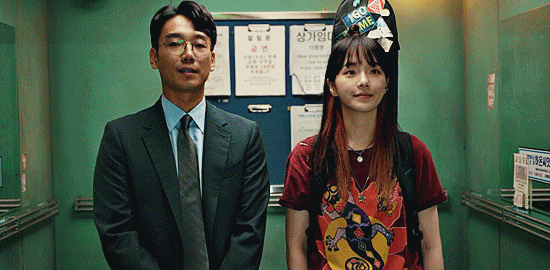
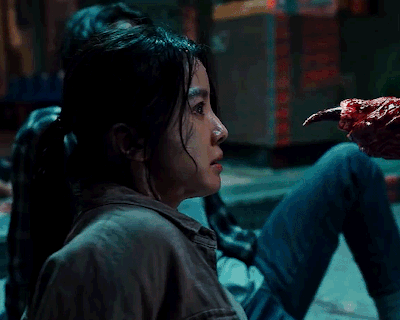
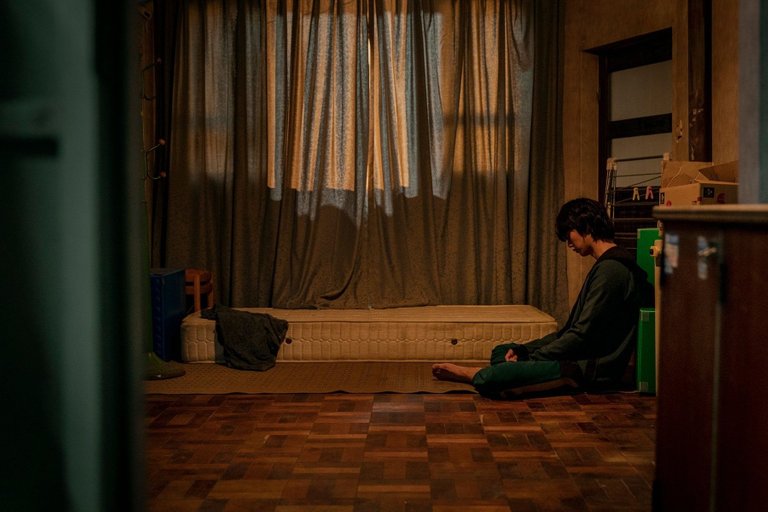

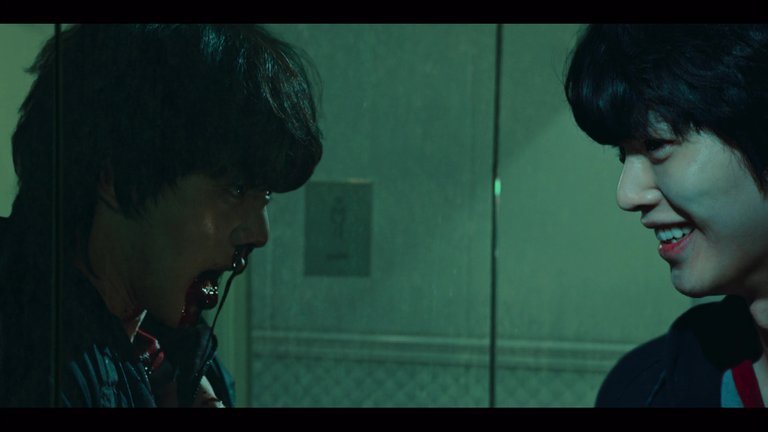
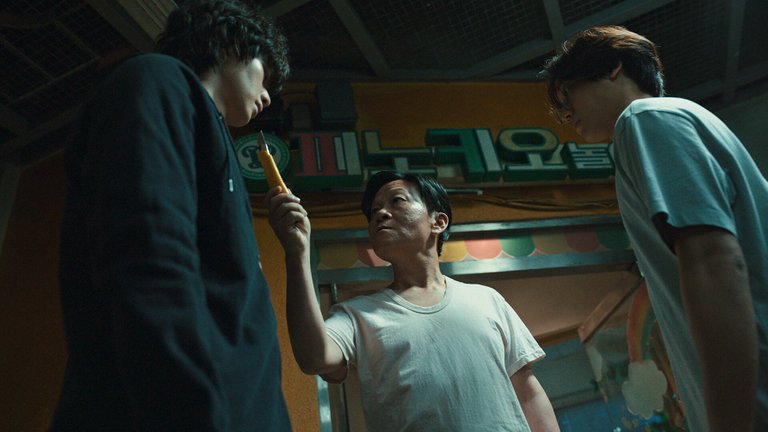
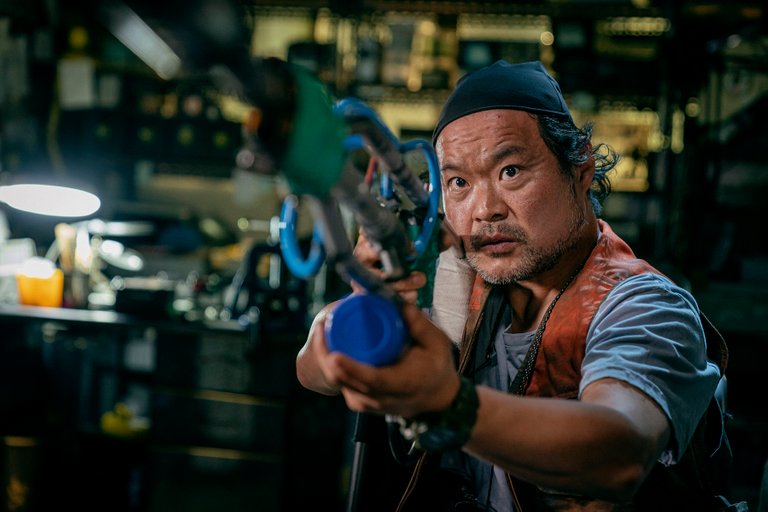
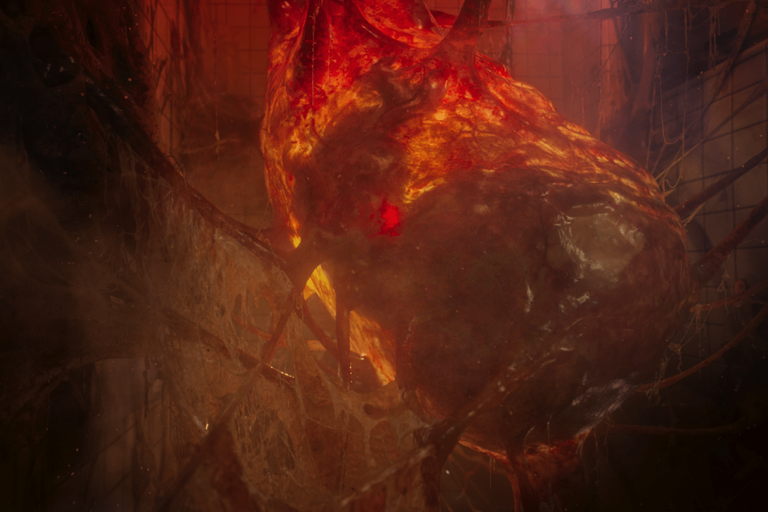
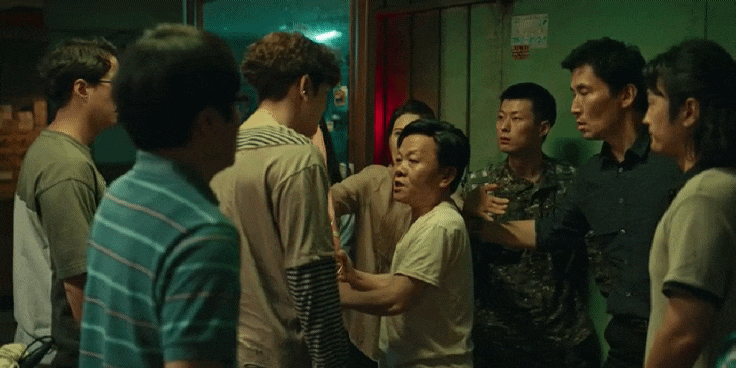
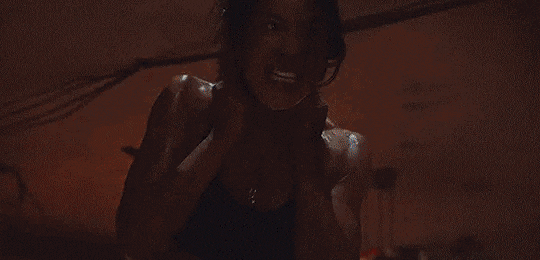

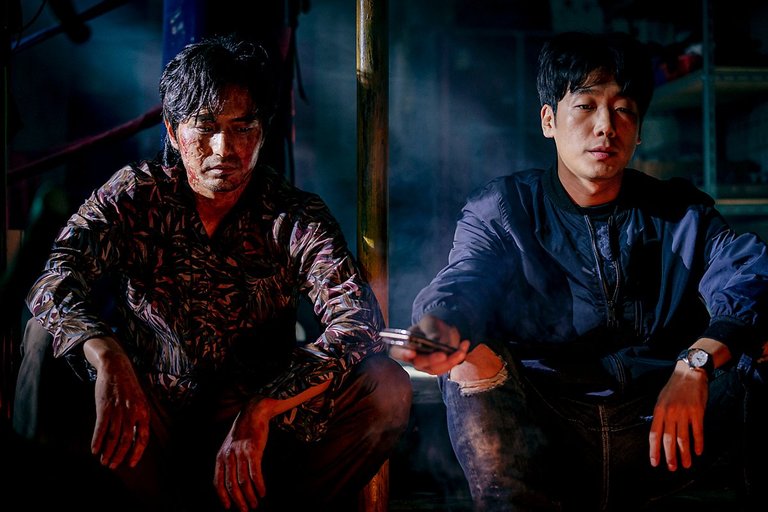
Ok, que la fuente de estos zombies no sea un virus hecho en laboratorio o algún azar del destino genético ya le agrego tremendos puntazos y me hizo agregarla a mi lista de pendientes por ver, saludos, buena publicación :)
Si te gusta leer, lo re-recomiendo el webtoon, algunos temas son mucho más detalladas y profundizados que en la adaptación – y principalmente, no te vas a decepcionar el final (estoy un poco aprensiva por las próximas temporadas en realidad...)
Saludos! Gracias por comentar!
Usualmente sucede eso con las adaptaciones, pero igual seria genial ver el caso contrario, por ahora me tocara echarle un ojo al webtoon, gracias por la recomendacion :)
Congratulations @zombialien! You have completed the following achievement on the Hive blockchain And have been rewarded with New badge(s)
Your next target is to reach 3250 upvotes.
You can view your badges on your board and compare yourself to others in the Ranking
If you no longer want to receive notifications, reply to this comment with the word
STOPCheck out our last posts:
Support the HiveBuzz project. Vote for our proposal!
Nice and very concise write-up. I felt as though this series got stale pretty fast and for me, there were too many characters for me to really keep up with what was going on. I suppose that for the right person they might really enjoy this but I only made it about 3 episodes before I had enough :)
Indeed, the several characters with several different backgrounds and personalities weren't explored properly in the series – Idk if you have read the webtoon, but there was way more space to explore them there, both their past and present. I think if it had more episodes, these issues could be improved somehow – or maybe not, since it'd be more slow-paced... haha
Thanks for your comment!
I didn't realize there was a webtoon but I suppose all of these ideas for series and films have to come from somewhere. I'll check that out and thanks for the info!